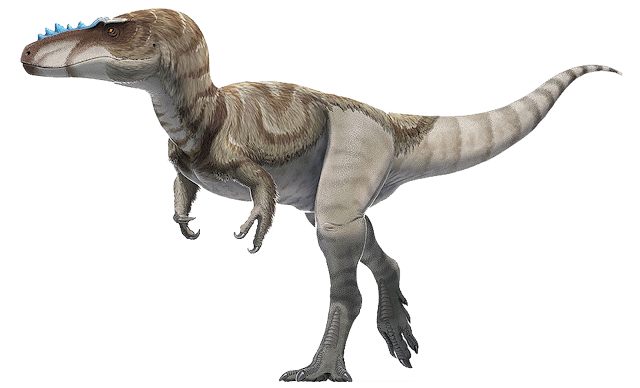- Pronunciation: (Ah-Lee-Oh-Ram-Us)
- Meaning: "Different Branch"
- Length: 19ft
- Height: 6ft
- Diet: Carnivorous
- Time: Cretaceous (75 MYA)
- Region: Asia (Mongolia)
Alioramus, a midsized tyrannosaur from the Late Cretaceous
(72-66MYA) of Mongolia, is yet another dinosaur grounded in mystery due to
scant remains. However, even though this is the case, many details about the
animal can be extrapolated from the few remains that have been uncovered.
 |
| Alioramus Skull Reconstruction |
A Soviet-Mongolian expedition to the Gobi Desert of Mongolia
in the early 1970s uncovered the remains of Alioramus, but it was not until
1976 that soviet paleontologist, Sergei Kurzanov, identified the remains.
Kurzanov found the animal to be a tyrannosaur and named it Alioramus remotus,
which translates to “Removed Other Branch”. Kurzanov named his find after the
fact that the animal contained characteristics of no other animal of the family
it belonged to. Kurzanov placed the animal in the general superfamily
Tyrannosauroidea. Alioramus remained a very partial species with only
fragmentary skull material having been found, until another much more complete
find was discovered in 2001 by Julia Clarke on another expedition to Mongolia
with the American Museum of Natural History and Mongolian Academy of Sciences.
This new species was named Altai, in homage to the Altai Mountains in Mongolia in
2009. This new find consisted of a nearly complete skull, missing just a few
minor bones, a complete neck, large segments of the back, sacrum, tail, a
nearly complete pelvis, and most of the hind limbs. Although still rather
fragmentary, the animal can now be rather accurately reconstructed with a
proper body.
 |
| Alioramus Reconstruction (Art and Copyright belongs to Fred Wierum; FredtheDinosaurman on DeviantArt) |
What is known of Alioramus is scant, but what is known is
rather interesting. Alioramus is known only from juvenile specimens, and as
such, the adult size cannot be fully determined. However, the juvenile
specimens uncovered suggest an length of approximately 15-19ft; juvenile
Alioramus would have stood as tall as an adult human. The most distinguishing
features of Alioramus is its skull. The animal had a very gracile skull much
more elongate than the majority of other known Tyrannosaurs (minus
Nanotyrannus), not only this, but the skull sported a series of about 5-6 small
hornlets that ran along the snout and jutted upwards about 1-2 inches. Due to
the fact that the remains only represent juvenile specimens, scientists had
hypothesized that Alioramus might be the juvenile of the larger tyrannosaur
that it shared its environment with; Tarbosaurus. However, juvenile specimens
identified to belong to the genus Tarbosaurus with differing characteristics to
Alioramus suggest that the animal was a different species altogether. Slender
features and legs like that of an Ornithomimosaur, suggests that Alioramus
would have preyed upon smaller animals in comparison to the much larger and
more robust Tarbosaurus.
 |
| Alioramus Reconstruction with scale (Art and Copyright belongs to Robinson Kunz; Teratophoneus on DeviantArt) |
Mongolia, the region of which Alioramus called home, is home
to a vast array of other animals that we know a lot about due to over 30 years
of research and discovery in the region. Tarbosaurus, Deinocheirus, Gallimimus,
Therizinosaurus, Homalocephale, and Nemegtosaurus all shared the ecosystem with
Alioramus.
Works Cited:
"Alioramus." Wikipedia. Wikimedia Foundation, n.d.
Web. 30 Dec. 2015. <https://en.wikipedia.org/wiki/Alioramus>.
Switek, Brian. "Alioramus Altai: A New, Multi-Horned
Tyrant." Smithsonian. Smithsonian, 6 Oct. 2009. Web. 30 Dec. 2015.
<http://www.smithsonianmag.com/science-nature/alioramus-altai-a-new-multi-horned-tyrant-54512057/?no-ist>.
Murray, Melissa. "Australian Museum." Alioramus
Altai -. Australian Museum, 20 Nov. 2013. Web. 30 Dec. 2015.
<http://australianmuseum.net.au/alioramus-altai>.
Hone, Dave. "Guest Post: A New Tyrannosaur - Alioramus
Altai." Dave Hones Archosaur Musings. Word Press, 05 Oct. 2009. Web. 30
Dec. 2015.
<https://archosaurmusings.wordpress.com/2009/10/06/guest-post-a-new-tyrannosaur-alioramus-altai/>.




No comments:
Post a Comment